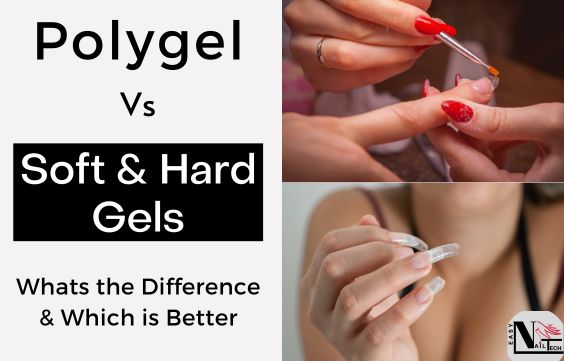Polygel vs Soft & Hard Gel – Differences & Which is Better

They are so many different types of manicures and nail products available. So much so that even veteran nail techs like myself can get confused, especially with the newer products.
Now one of the areas that can be very confusing is the different types of gel nail products.
So that is why in this article, I am going to focus on Polygel, Soft gel, and Hard gel and explain the pros and cons of each to help you decide which is right for you.
Difference Between Polygel, Soft Gel & Hard Gel
The main difference between Polygel and Hard gel is that Polygel has a much thicker consistency when compared to hard gel.
Polygel’s thicker consistency makes it easier to sculpt or build out nails and make nail extensions. This makes it perfect to do manicures at home, especially for beginners.
Hard gel and Polygel are best for making nail extensions. Whilst soft gel has a thinner consistency which is more similar to nail polish and is better for just adding strength and thickness, and in the case of gel polish add color to your nails.
Bonus Tip
Gel manicures can be very harsh on your nails and cuticles. This is why I recommend applying a good nail serum right after application. But sadly most cuticle oils are just plain oils and not very good.
This is why I formulated a new complete nail serum that is jam-packed with nutrients to help you have healthy nails. You can click here to get it on Amazon. Also if you get one you will greatly help me to continue making content, so thank you so much.
Related Articles –
Polygel vs Acrylic: What is the Difference & Which is Better
Gel X vs Polygel- Which is Stronger & Easier to Apply
Hard Gel Extensions: How to Apply, Benefits & Risks
Video Showing the Difference Between Hard Builder Gel Vs Polygel
Hard Gels
Hard gels are used to make nail extensions. This is what most nail salons would use to make those long gel nails.
They are extremely strong, won’t stain easily, and can last you 3 to 4 weeks. Hard Gels cannot be removed by soaking in acetone and will need to be filed off usually by using an electric nail file.
Hard gels usually come in jars and you will need a gel brush to work with them. Hard Gels tend to have a thicker consistency than soft gels but a thinner consistency than Polygel.
Though the consistency of Hard Gel will vary with each brand of gel. Hard gels can be used to make nail overlays too.
Related Articles –
2 Ways to Remove Hard Gel at Home (With & Without Drill)
Hard Gel vs Gel X- Differences & Which is Better
Polygel
Polygel is usually used to make nail extensions and was made as an alternative to both hard gel and acrylic nails.
Now the advantage of Polygel over hard gel is that it has a thicker consistency which makes it easier to apply especially for beginners. Polygel usually comes in tubes.
Some brands of Polygel are hard gels meaning you cannot remove them with acetone and will need to be filed off. Whilst some brands are soft gels meaning you can soak them off with acetone.
Related Article –Does Polygel Damage Nails- What are the Pros & Cons
Soft Gel
Soft Gel Products tend to have a thin consistency similar to polish except they are a bit thicker. Soft gels are usually used as:
- A Nail Overlay meaning they add strength and thickness to your natural nails – which allows them to grow longer and be shaped to your liking examples of soft gel that is used for overlays are BIAB gels.
- To add color to your nails – gel nail polishes are considered a form of soft gel.
Soft gels can be removed by being soaked in acetone, they are also weaker and more easily damaged when compared to hard gels and polygel. Soft Gel usually comes in nail polish bottles and is applied using a polish brush.
They can be used to make short nail extensions but I don’t recommend using them to make very long extensions.
Now I have noticed that some soft gel products are becoming thicker allowing them to make longer extensions so once again it depends on the brand that you get. A good way to know is if it comes in a jar and you need a brush then you might be able to make long extensions.
Related Article – What are Soft Gel Nail Tips: How to Apply & Pros & Cons
Builder Gels
Builder gel is an open term that can describe both soft and hard gel. In some cases, builder gel can refer to hard gel, and in others soft gel.
But generally, Builder Gels are any gel used to build out the nails either by extending them or making them thicker.
I would describe builder gels as any gel nail product that is not a gel polish.
Polygel Vs Hard Gel
Both Polygel and Hard Gel are mostly used to make nail extensions. But they can both also be used as a nail overlay meaning to reinforce and thicken your natural nails.
They also both require a UV-Led Lamp to cure and harden. But they are significant differences between both Polygel and Hard Gel.
| Hard Gel/Builder Gel | Polygel | |
| Ease of Application | Hard Gel will require more practice and training to apply | Polygel is easier to apply especially for beginners |
| Durability | Hard Gel tends to last longer and is tougher than Polygel | From my experience, Polygel won’t last as long as Hard Gel |
| Ease of Removal | Hard Gels tend to require more work to take off and will need to be filed off. | Polygel tends to be easier to remove and for most brands, you can use acetone to soak off |
| Appearance | Hard Gel will look just as good as Polygel | Once applied correctly Polygel will look the same as Hard Gel |
| How it feels | Hard gel is a bit more rigid so it can feel a bit more unnatural than Polygel | From my experience, Polygel won’t last as long as Hard/Builder Gel |
| Packaging | Hard Gels tend to come in jars. | Polygel comes in thick tubes. |
Which one is Easier to Apply – Polygel Or Hard Gel
I have been using both Polygel and Hard Gel for years now and in my opinion, Polygel is much easier to apply when compared to hard gel, especially if you are now getting started with either product.
Polygel has a thicker consistency similar to acrylic which is easier to sculpt since it stays in place better and won’t move around unless you move it. Whilst hard gel has a runny consistency which is harder to control and work with.
The thick consistency of Polygel also allows it to be applied using plastic dual forms. Using Dual Forms is amazing since it is one of the fastest ways to create extensions since they don’t require so much filing.
Also due to the thick consistency Polygel goes on much faster than Hard Gel. Hard Gel will usually need to be applied in layers and each layer needs to be cured. Whilst polygel can be applied in one bead and then cured.
You can click here to read the 4 Ways to Apply Polygel at Home Or you can the video below to see what are Dual Forms
Video – How to Use Polygel with Dual Forms
Which one will Last Longer – Polygel or Hard Gel
From my experience, Hard gels tend to last longer than Polygel but this will vary greatly depending on the brands used. Some brands of Polygel are extremely durable and long-lasting and can easily match hard gels.
Hard Gel tends to resist impact better and is less likely to get deformed since it is harder and stiffer and it is less likely to be affected by things like wear and tear, chemicals, and heat. Polygel is softer and certain activities like constant typing or tapping will lose its shape, also polygel is more prone to peeling and fading.
Polygel’s advantage is that it is more flexible and less likely to break when bent whilst hard gel is more stiff and hard so it is more prone to breaking. Polygel is also less likely to lift since it flexes and stays with your natural nails.
You can click here to read about How Long Polygel Nails will Last & How to Make them Last Longer
Which is Easier to Remove
Polygel will be easier to remove when compared to Hard/Builder Gels. All hard gels need to be filed off and usually, with an electric nail file. They cannot be removed with acetone.
Some brands of Polygel can be removed using either acetone or filing. But some brands will need to be filed off. Now thankfully generally Polgel tends to be softer and easier to remove when compared to Hard Gel.
You can click here to read How to remove Polygel at Home
Which one Feels & Looks Better
Once applied correctly both Polygel and Hard Gel will identical and you won’t be able to tell the difference between the 2.
Now from my experience, Polygel tends to feel more natural. I suspect this is because Polygel is more flexible which allows it to bend and flex with your natural nails.
Now this will vary greatly depending on the brand of Polygel that you use. You can click here to read my favorite brands of Polygel.
Hard Gel, on the other hand, is very stiff and rigid so it won’t flex and move with your nails. This gives it a more artificial feeling.
Related Article – Polygel Overlay on Short Nails- How to Apply, Pros & Cons
Polygel Vs Soft Gel
Both Polygel and Soft Gel have 2 different purposes. Polygel is used to make nail extensions. Whilst Soft gel on the other is used as an overlay meaning to reinforce and strengthen your natural nails or it can be used to make very short nail extensions.
Polygel will also have a thicker consistency whilst Soft Gels tend to have a very thin-watery consistency more similar to nail polish.
Now the official definition of a soft gel is – a gel nail product that can be removed by being soaked in acetone. And because of this, some brands of polygel that can be soaked off can be considered as a soft gel.
But in practical terms, soft gel and polygel are 2 very different products. Examples of soft gel are:
- Gel Polish – which is a type of nail polish that requires a UV-Led Lamp to cure and dry.
- Builder in a Bottle – which is similar to gel polish except it is thicker and can be used to reinforce your nails and even make short extensions. Click here to learn more about BIAB Nails.
- Rubber Base Gels – are very thick base coats that can be used both as a gel base coat and as an overlay. Click here to learn more about Rubber Base Gels
Related Articles:
6 Reasons Why Polygel Breaks or Lifts- How to Fix & Avoid
3 Easy Ways to Fill Polygel Nails at Home (w/Video)
